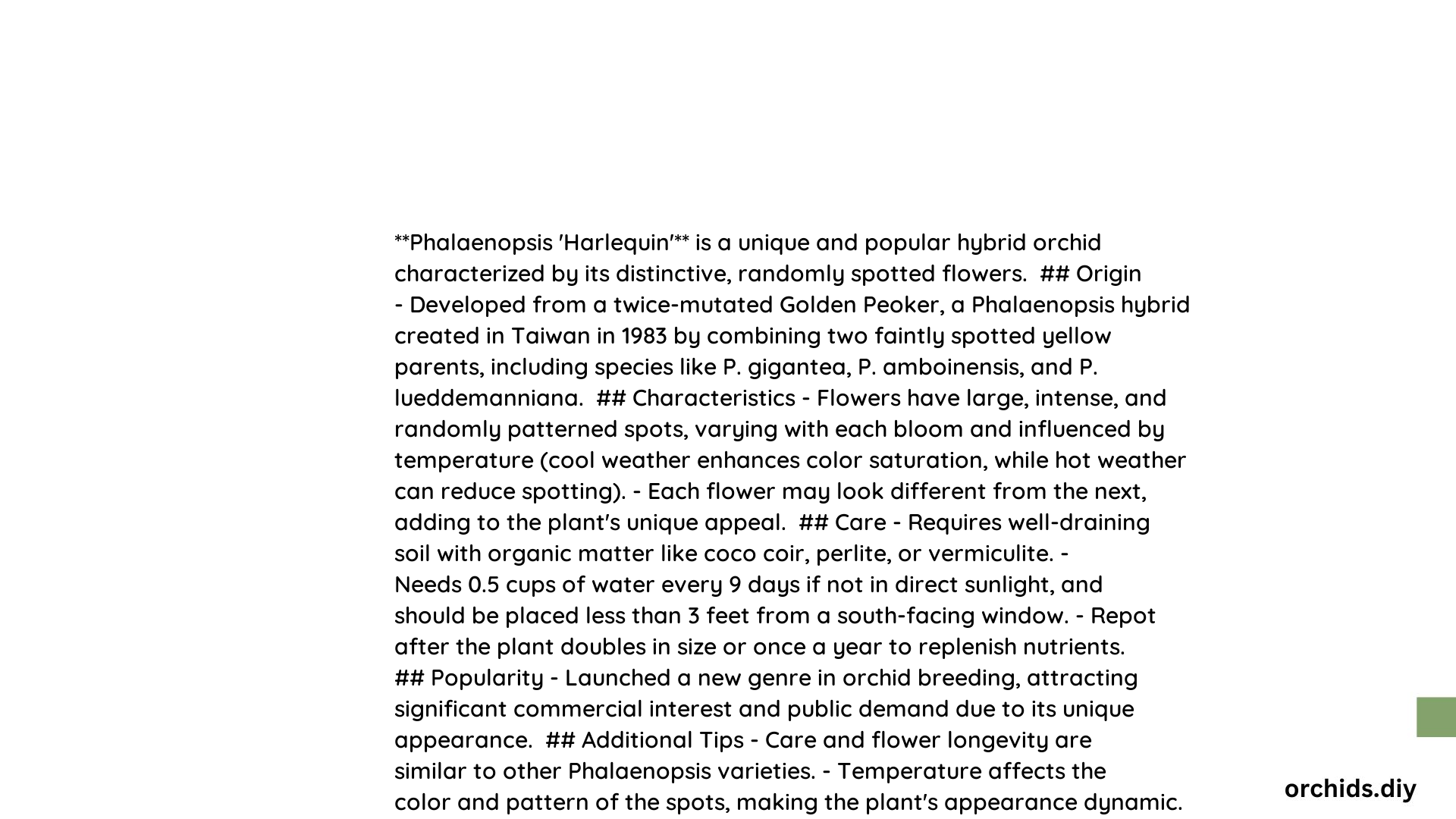Phalaenopsis Harlequin is a captivating orchid variety known for its unique, speckled blooms. These orchids feature flowers with a base color adorned with contrasting spots or splashes, creating a striking visual effect. Harlequin Phalaenopsis are prized for their long-lasting blooms and relatively easy care requirements, making them popular among both novice and experienced orchid enthusiasts. Their distinctive appearance and adaptability to indoor environments have contributed to their widespread cultivation and admiration.
What are the Unique Characteristics of Phalaenopsis Harlequin?
Phalaenopsis Harlequin orchids stand out due to their distinctive floral patterns:
- Speckled Blooms: The flowers exhibit a base color with contrasting spots or splashes.
- Color Variations: Common color combinations include white with purple spots, pink with darker pink spots, or yellow with red speckles.
- Bloom Size: Flowers typically range from 2 to 5 inches in diameter.
- Long-lasting Flowers: Blooms can persist for several months under proper care.
- Compact Growth: Plants generally have a rosette form with broad, fleshy leaves.
How to Provide Optimal Care for Phalaenopsis Harlequin?

To ensure your Phalaenopsis Harlequin thrives, follow these care guidelines:
Light Requirements
- Bright, indirect light (1000-1500 foot-candles or 10,000-16,000 lux)
- Avoid direct sunlight
- East or west-facing windows are ideal
- Artificial lighting: LEDs or fluorescent tubes 6-12 inches above leaves for 12-16 hours daily
Temperature and Humidity
- Daytime temperatures: 70°F to 85°F (21°C to 29°C)
- Nighttime temperatures: Above 60°F (16°C)
- Humidity: 50-80%
- Use a humidifier or humidity tray to maintain moisture levels
Watering and Fertilization
- Water thoroughly when the potting medium is slightly dry
- Use low-alkalinity water (rainwater, distilled, or reverse osmosis)
- Fertilize weekly with a balanced, water-soluble orchid fertilizer at 1/4 strength
What is the Ideal Potting Medium for Phalaenopsis Harlequin?
Choosing the right potting medium is crucial for the health of your Phalaenopsis Harlequin:
| Medium Type | Characteristics | Benefits |
|---|---|---|
| Bark Mix | Coarse, well-draining | Prevents root rot, allows air circulation |
| Sphagnum Moss | Moisture-retentive | Ideal for drier environments |
| Perlite/Vermiculite Mix | Lightweight, airy | Improves drainage and aeration |
Select a medium that suits your watering habits and local climate. A mix of bark, perlite, and charcoal is often recommended for its balance of moisture retention and drainage.
How to Encourage Blooming in Phalaenopsis Harlequin?
To promote flowering in your Phalaenopsis Harlequin:
- Provide a temperature drop: Expose the plant to cooler nights (around 55°F or 13°C) for about two weeks in autumn.
- Maintain consistent care: Stable light, humidity, and watering routines support healthy growth and blooming.
- Proper fertilization: Use a phosphorus-rich fertilizer during the growing season to encourage flower spike development.
- Adequate light: Ensure the plant receives sufficient bright, indirect light throughout the year.
- Avoid stress: Minimize repotting or relocating the plant when flower spikes are developing.
What are Common Pests and Diseases Affecting Phalaenopsis Harlequin?
Phalaenopsis Harlequin can be susceptible to various pests and diseases:
Pests
- Mealybugs
- Spider mites
- Scale insects
- Aphids
Diseases
- Root rot (caused by overwatering)
- Bacterial soft rot
- Botrytis blight (gray mold)
- Viral infections (e.g., Cymbidium Mosaic Virus)
How to Propagate Phalaenopsis Harlequin?
Propagation of Phalaenopsis Harlequin can be achieved through several methods:
- Keiki (Pup) Propagation:
- Wait for the mother plant to produce keikis on the flower spike
-
Once the keiki has developed roots and leaves, carefully remove and pot it
-
Stem Cuttings:
- Cut the flower spike about an inch above a node after blooming
-
This may encourage new flower spike or keiki formation
-
Division:
- Divide mature plants during repotting
-
Ensure each division has sufficient roots and leaves
-
Meristem Culture (Advanced):
- Performed in laboratory settings
- Not recommended for home growers
What are the Best Display Options for Phalaenopsis Harlequin?
Showcase your Phalaenopsis Harlequin with these display ideas:
- Clear orchid pots: Highlight the plant’s aerial roots
- Decorative ceramic containers: Choose colors that complement the flower’s hues
- Hanging baskets: Create a cascading effect with multiple plants
- Terrariums: Create a miniature tropical environment (ensure proper ventilation)
- Orchid stands: Elevate single plants or create multi-tiered displays
How to Troubleshoot Common Issues with Phalaenopsis Harlequin?
Address these common problems to maintain a healthy Phalaenopsis Harlequin:
- Yellowing leaves:
- Cause: Overwatering or poor drainage
-
Solution: Adjust watering frequency and improve potting medium drainage
-
Wrinkled leaves:
- Cause: Underwatering or low humidity
-
Solution: Increase watering frequency and raise humidity levels
-
Bud drop:
- Cause: Sudden temperature changes or drafts
-
Solution: Maintain stable environmental conditions
-
Lack of blooming:
- Cause: Insufficient light or lack of temperature fluctuation
-
Solution: Adjust light conditions and provide a cool period in autumn
-
Brown leaf tips:
- Cause: Mineral buildup from hard water
- Solution: Use low-alkalinity water and flush the potting medium regularly
By following these care guidelines and addressing potential issues promptly, you can enjoy the stunning beauty of Phalaenopsis Harlequin orchids in your home or collection.
References:
1. Brooklyn Botanic Garden – Phalaenopsis Care
2. OrchidWeb – Phalaenopsis Orchid Care
3. Guna Orchids – Phalaenopsis Care Guide
